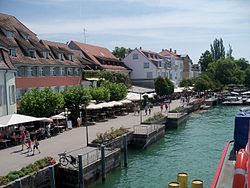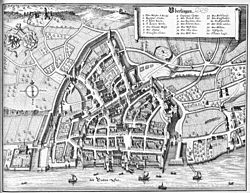Bonndorf (Überlingen)
| Überlingen | ||
|---|---|---|
 |
||
|
||
| Coordinates: 47°46′0″N 9°9′30″E / 47.76667°N 9.15833°ECoordinates: 47°46′0″N 9°9′30″E / 47.76667°N 9.15833°E | ||
| Country | Germany | |
| State | Baden-Württemberg | |
| Admin. region | Tübingen | |
| District | Bodenseekreis | |
| Government | ||
| • Mayor | Jan Zeitler (SPD) | |
| Area | ||
| • Total | 58.67 km2 (22.65 sq mi) | |
| Elevation | 403 m (1,322 ft) | |
| Population (2015-12-31) | ||
| • Total | 22,408 | |
| • Density | 380/km2 (990/sq mi) | |
| Time zone | CET/CEST (UTC+1/+2) | |
| Postal codes | 88662 | |
| Dialling codes | 07551 | |
| Vehicle registration | FN | |
| Website | www.ueberlingen.de | |
| Free Imperial City of Überlingen | ||||||||||
| Reichsstadt Überlingen | ||||||||||
| Free Imperial City of the Holy Roman Empire | ||||||||||
|
||||||||||
|
Überlingen 1640–50, Engraving by Mathäus Merian
|
||||||||||
| Capital | Überlingen | |||||||||
| Government | Republic | |||||||||
| Historical era | ||||||||||
| • | Gained city rights | 1211 | ||||||||
| • | Gained Imp. immediacy | 1268 | ||||||||
| • | Occupied by Sweden in Thirty Years' War | 1643–48 | ||||||||
| • | Mediatised to Electorate of Baden | 1803 | ||||||||
|
||||||||||
Überlingen is a German city on the northern shore of Lake Constance (Bodensee). After the city of Friedrichshafen, it is the second largest city in the Bodenseekreis (district), and a central point for the outlying communities. Since January 1, 1993, Überlingen has been categorized as a large district city (Große Kreisstadt).
The history of Überlingen dates back to Roman times, but a variety of settlements pre-dated Roman occupation. Stone age settlements, discovered along the shoreline of Lake Constance, document that the lake supported several dozen thriving communities of 50–100 individuals. These settlements fall under the category of the Hallstatt culture, and their habits, dress, and diet has been illuminated through the excavation of archaeological sites, such as a major site in Hallstadt, Austria, excavated in the mid-to late 19th century.
Similar sites, although smaller, have been found in vicinity of Überlingen: a site near Hodingen, another near Dettingen, by Constance, and a major site near the village of Unteruhldingen, where there is now an open air archaeological museum.
The dead were either burned, or buried in mounds or flat graves; women wore jewelry made of bronze or gold, especially earrings. Tools uncovered in archeological excavation suggest that these communities engaged in a combination of hunting, fishing and agriculture.
The Alpine lands and the eastern Swiss Plateau were overrun by the troops of the emperor Augustus (31 BCE to 14 CE), who established the Roman writ from the Alps to the Danube, through the efforts of Augustus' stepsons Drusus and Tiberius. According to some interpretations of the Roman records, one of the Bodensee islands, probably Mainau was the operations base for the military operations in the year 15 BCE.
The necessities of troop transport and ship building and maintenance required the Romans to possess the entire Swiss shore of the lake, and from these points along the lake, the Romans could mount a double-pointed excursion to the eastern Tyrol and present-day Bavaria, or to the West, in the Rhine valley. The Bodensee region, as a Roman province administered from Augusta Vindelicorum, present day Augsburg, was governed by a Finance official (Procurator) under Tiberius's command. The road from Stockach to Überlingen, and then along the lake's shore to Uhldingen and on to Friedrichshafen, and the east-west train tracks, generally follow the path of the old Roman road.
...
Wikipedia



